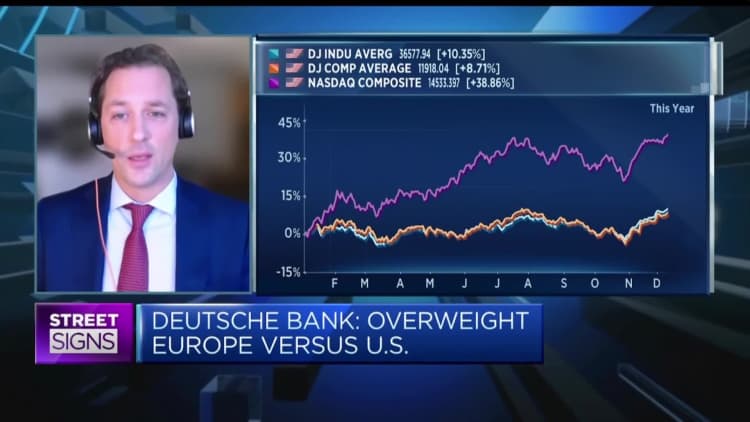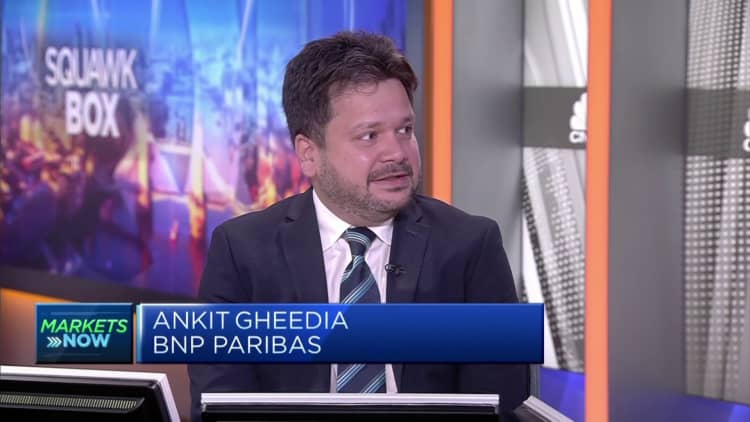
European equities are set to outperform the U.S. in the first half of 2024 — but they need to get through some near-term headwinds first, strategists told CNBC.
“We are generally quite positive on next year,” Maximilian Uleer, head of European equity and cross-asset strategy at Deutsche Bank, told “Squawk Box Europe” on Wednesday.
“Three weeks ago we called for an overweight in Europe. It’s more of a tactical view, we think that’s going to work out better in the first half of the year than in the second one.”
One reason, Uleer said, is that “surprise indices” — which measure how much economic data beats or misses forecasts and by how much — are picking up in Europe and coming down in the U.S., even if the absolute level of growth is much stronger in the latter.
The direction of travel in economic data, for example in inflation figures, is also “more interesting” in Europe than the U.S. right now, he added.
Ankit Gheedia, head of equity strategy at BNP Paribas, echoed this sentiment and also expects Europe stocks to outperform the U.S. next year.
“When you see the economic surprise difference between Europe and U.S., that tends to correlate well between Europe and U.S. equity outperformance. Middle of this year, outlook and sentiment for European economy was quite poor. Things are getting less bad right now,” Gheedia told CNBC Wednesday.

He said that while most of Europe has avoided a technical recession, purchasing managers’ index figures have been languishing in the mid-40s — well below the 50 mark separating contraction from expansion, while businesses are struggling with destocking. European equity funds have seen 40 weeks of outflows, in line with a sluggish growth environment, Gheedia added.
“We do feel that things are getting less bad, and that will continue… next year. In the U.S., probably things are getting less good. Q3 was fantastic, but we don’t expect that performance to continue into 2024,” he said.
Valuations and earnings
Another reason to be bullish on Europe, according to Deutsche Bank’s Uleer, is that investors will “start to look for relative value trades.”
Stocks are trading at an “all-time multiple discount to the U.S.,” he noted, creating opportunities in the first half before things “level out again” in the second half. Europe stocks have a longstanding history of trading at a significant discount compared to their U.S. peers.
The forecasts come despite the stellar performance of the U.S.’s so-called “Magnificent Seven” stocks — Apple, Amazon, Alphabet, Nvidia, Meta, Microsoft, and Tesla — which have collectively gained more than 70% this year, according to Goldman Sachs.
The pan-European Stoxx 600 index is up almost 13% in the year to date, off the back of a 12.9% fall in 2022. It hit a 52-week high on Thursday.
The S&P 500, meanwhile, is up 22.6%, a reversal from 2022’s 19.4% decline. It is in the wake of significant momentum in recent months, with investors pricing in central bank rate cuts next year given sharp falls in inflation.
Despite some economic gloom in the euro zone’s largest economy Germany, the country’s DAX index has also been on a strong run and hit a record high in December.

DAX index.
Uleer cautioned that he expects the DAX’s run to come to an end in the “very near term,” along with other European indices. His bullish outlook is rather for the whole first half of next year.
That’s because of the opportunity for negative market surprises, he said, particularly as central banks temper expectations over rate cuts.
But Uleer sees “more upside on the multiple front from those lower rates” for European equities in general — and also upside from earnings.
“Same for the DAX as for the other indices in Europe … consensus only expects 2% earnings growth for next year, which is quite benign. And we think it could easily be 5%, which is still quite conservative, I would say,” he said.
“Mixing those two together, so slightly higher multiples, slightly [better] earnings, we see 8% upside for the DAX and for the rest of Europe for next year. Which is quite a bit higher than peers.”

